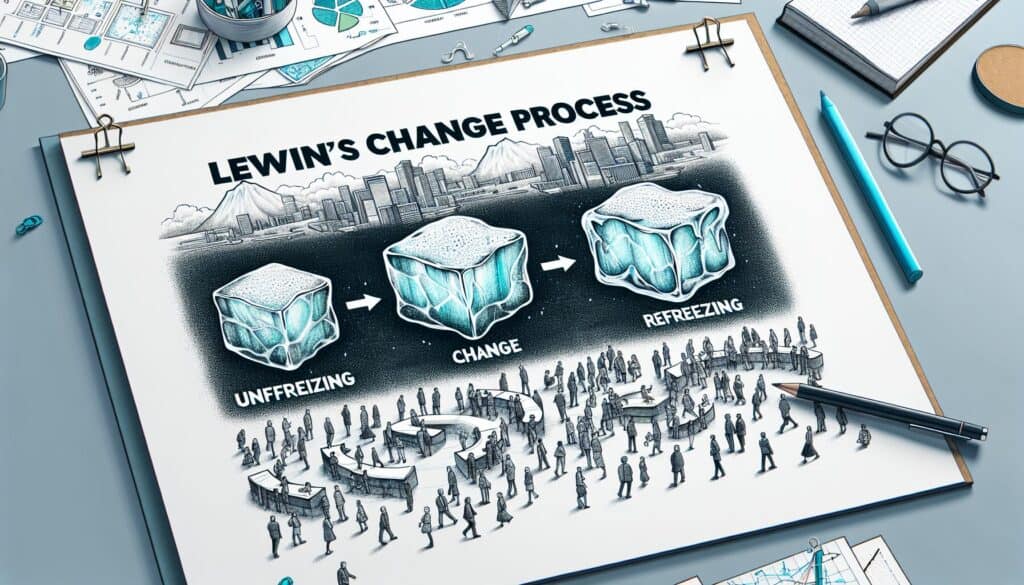Per fornire un struttura per la gestione del cambiamento organizzativo.
- Metodologie: Economia, Lean Sigma, Produzione, Risoluzione dei problemi, Qualità
Il processo di cambiamento in 3 fasi di Lewin

Il processo di cambiamento in 3 fasi di Lewin
- Metodologia agile, Gestione del cambiamento, Miglioramento continuo, Pensiero progettuale, Produzione snella, Trasformazione organizzativa, Miglioramento dei processi, Gestione del progetto, Gestione della qualità
Obiettivo:
Come si usa:
- Un modello che descrive il cambiamento come un processo in tre fasi: Scongelamento (preparazione al cambiamento), Cambiamento (attuazione del cambiamento) e Ricongelamento (stabilizzazione del cambiamento e sua permanenza).
Professionisti
- Semplici e di facile comprensione; Forniscono un chiaro tabella di marcia per il cambiamento; sottolinea l'importanza di preparare le persone al cambiamento e di rafforzarlo.
Contro
- Può essere troppo semplicistico per cambiamenti complessi o rapidi; presuppone un processo lineare, il che potrebbe non essere sempre vero; non offre indicazioni dettagliate su come gestire la resistenza o tattiche di cambiamento specifiche.
Categorie:
- Risorse umane, Gestione del progetto
Ideale per:
- Guidare le organizzazioni attraverso i cambiamenti pianificati, fornendo un approccio strutturato e graduale.
In the realm of product design, innovation, science, and engineering, Lewin’s 3-stage Change Process can significantly support organizations in adapting to new market demands or technological advancements. This methodology finds application across various industries, including technology, healthcare, and manufacturing, where systematic change is frequent and necessary. For instance, during the development of advanced medical devices, the Unfreezing stage might involve gathering stakeholder feedback to identify existing limitations in current products and preparing teams for new regulatory standards. In the Changing phase, cross-functional teams might implement agile methodologies to accelerate prototyping and testing processes, ensuring rapid iterations that reflect user needs. The Refreezing stage would then involve embedding new processes and practices by training staff and establishing quality control measures to solidify these changes. Typically, change initiatives are championed by project managers, team leaders, or executives who possess a vision for innovation and foster collaboration among team members. Communication is critical throughout all stages, ensuring everyone is aware of their role and the goals of the changes, thus reducing resistance and encouraging acceptance. As a structured approach, Lewin’s model provides a clear and concise framework, enabling organizations to visualize transitions and maintain momentum to effectuate lasting improvements in performance and product quality.
Fasi chiave di questa metodologia
- Identify and communicate the need for change to stakeholders.
- Challenge existing beliefs and behaviors that resist change.
- Facilitate training and support for employees during the transition.
- Implement the change initiative with clear actions and timelines.
- Monitor the change process and make necessary adjustments.
- Reinforce new behaviors and practices through incentives.
- Establish systems and processes to sustain the change long-term.
Suggerimenti per i professionisti
- Invest in change champions within the organization to facilitate communication and reduce resistance during all three stages.
- Utilize data analytics to assess the impact of the change during the Changing phase, allowing for real-time adjustments and feedback loops.
- Develop a reinforcement plan in the Refreezing phase that includes continuous training and recognition programs to sustain the change long-term.
Leggere e confrontare diverse metodologie, raccomandiamo il
> Ampio archivio di metodologie <
insieme ad altre 400 metodologie.
I vostri commenti su questa metodologia o ulteriori informazioni sono benvenuti su sezione commenti qui sotto ↓ , così come tutte le idee o i link relativi all'ingegneria.
Contesto storico
1962
1970
1972
1980
1980
1986
1986
1960
1963
1970
1980
1980
1980
1986
1987
(se la data non è nota o non è rilevante, ad esempio "meccanica dei fluidi", viene fornita una stima approssimativa della sua notevole comparsa)















Post correlati
Gestione delle operazioni di produzione (MOM)
Sistema di esecuzione della produzione (MES)
Piano di controllo della produzione
Test manuali
Schede di valutazione della movimentazione manuale (MAC)
ManTRA (Strumento di valutazione dei rischi delle attività manuali)